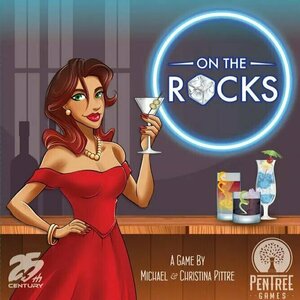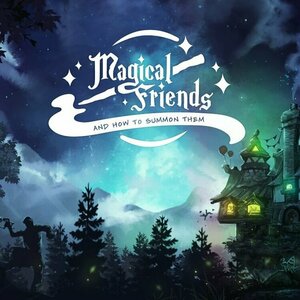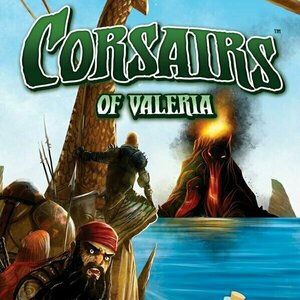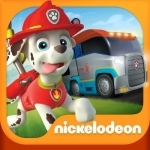
PAW Patrol Pups to the Rescue
Education and Games
App
Go on a rescue road trip with all your favorite pups in the new app: PAW Patrol Pups to the Rescue. ...
Purple Phoenix Games (2266 KP) rated On the Rocks in Tabletop Games
Sep 7, 2021
“On the Rocks is a marble drafting, cocktail recipe fulfillment game for 1-4 players. It is NOT a drinking game.” – straight from the game’s BGG page. So what does that mean? Well, this one is a variation of the “I cut, you choose” style game, but HEAVILY themed around bartending and enhanced with additional fun mechanics. The winner is the player who amasses the most amount of money by the end of their shift.
DISCLAIMER: We were provided a copy of this game for the purposes of this review. This is a retail copy of the game, so what you see in these photos is exactly what would be received in your box. I do not intend to cover every single rule included in the rulebook, but will describe the overall game flow and major rule set so that our readers may get a sense of how the game plays. For more in depth rules, you may purchase a copy online or from your FLGS. -T
To setup, consult the rulebook, as there are many steps. However, once setup, the game should look similar to the photo below. Choose the starting player and the mixology competition can begin!
On the Rocks is played over several rounds with each player completing specific steps. The first step is optional, and is Tip Cards. Players will accumulate Tip Cards throughout the game, and each one features a special ability that may be used at this time. The next step may also be optional, depending on if the active player had received a Complaint card previously. Complaints must be completed on this step and is pretty much a wrench thrown in the plans by competitors.
Once these (possibly) optional steps have been completed the active player then takes the 2d6 and Rolls them. This number determines how many ingredient marbles are to be pulled from the bag and added into play. For the cost of one ingredient marble, the active player may manipulate the rolled dice by flipping it to its opposite face. Next, the player will Draft the number of marbles from the bag they rolled in the previous step. From these drafted marbles the player will Mix them into the blue Jigger Bowls in the middle of the table one at a time, a la Mancala (oh that’s fun to say: A LA MANCALA!). Then the player will Select & Place a jigger of marbles from the table onto their player board. Placing the corresponding marbles onto the drinks is how recipes can be completed. If any ingredients were selected from the jigger but not placed, the player must then place the ingredients into the Extra Ingredients shot glasses on the top portion of the player board, to Save for later use.
When the ingredient marbles have been placed and saved, the player must then complete the Resolve step. Several ingredient marbles are “Premium” or “Spill” marbles. Premium marbles (golden) allow the player to select ANY two ingredients from the draw bag and the Premium marble is then discarded to the coaster in the middle of the table. The black Spill marble forces the active player to draw a Spill card from the deck and complete its action. It also during the Resolve step that the player may complete a recipe card by discarding the drink’s ingredients to the bag and flipping its recipe card face-down. If the entire order (all of the face-up recipe cards) is completed, the active player’s round ends and they notate this by placing one of the three lemon tokens on their player board. Some round end cleanup is performed, like drawing another set of 3 or 4 drink recipes for an order, and the player’s turn is over.
Once a player has completed their third order of drinks, they must indicate “Last Call” to the other players at the table. This informs the other players that they have one last turn to earn any extra money before the game ends. When the game has been finished, final scoring is performed and the winner is they who earned the most money throughout the night. The other players must immediately fix the winner a drink, or buy the winner a shot. Okay, those aren’t in the rulebook, but merely suggestions for the revised second edition…
Components. For those that follow our reviews, you know I am a sucker for games with great components, and this one definitely delivers for me. The aesthetics and art style are just perfect, the double-layer boards are always lovely, and the rubber jiggers are excellent. I cannot see anything that can be improved in terms of components, and I completely expected that because this was published by Pentree Games and 25th Century Games (one of my favorite publishers in the business). The game looks and feels deluxe, which is VERY satisfying.
I think that the Pittre duo of Michael and Christina really knocked it out of the park with this one. Wait, this is their first game design?? And it’s incredible? Okay okay, I’ll be keeping my eye on you two. On the Rocks is a light game with excellent table presence and some difficult choices presented. Now, the choices may be TOOOOOO difficult for some gamers, especially our AP-prone players. Carefully planning out each ingredient’s distribution into the jigger bowls can send them into a frenzy, so I have advised to choose one or two bowls they wish to buff and concentrate on hitting those with the marbles they want, and just randomly place the other ingredients. I know that is a big ask, but this game is supposed to take 45-90 minutes, not 45-90 hours. My other gripe about the game is the color-dependence of the ingredient marbles. I am sorry to all my colorblind friends out there, but I am unable to see how you might keep a possible 12 different marbles straight in your heads while simultaneously remembering the state of marbles in each jigger bowl. I hope I am completely wrong, as I do not suffer from colorblindness, and please do let me know if this is still playable for those gamers.
These gripes aside, everything else about the game is fabulous. I love being able to manipulate my dice rolls (yes, with a cost) to have ultimate control of the number of marbles pulled from the bag. That bag, however, takes control away immediately unless I draft a bunch of clear (wild) or golden marbles to affect my final placements. I also adore struggling to choose which recipes to concentrate on first, and weighing the possibilities of completing the higher value recipes, or blitzing the smaller ones first.
Oh, and the Spills cards? They can be real pains in the booty. These effectively give the active player the ability to completely botch another players’ plans by discarding their ingredient marbles from their player board. Not enough player interaction? How about negative Tip cards, which are earned by completing a recipe, that impede a competitor’s progress by making them complete the Tip card before being able to move on with their plans, or by limiting their marble selection to two instead of the entire bowl? Yeah, this has player interaction for sure.
Again, I like a good drink now and then, just as much as the next person. However, I have never been a bartender, and I do not plan on ever becoming one. I could not ever imagine having to compete with other bartenders for tip money either, especially if it is as brutally cutthroat as On the Rocks portrays it to be. I will, however, play a game where all that “fun” is diluted to dice, cards, and marbles. I was looking through my collection recently and noticed have embarrassingly few games with an adult beverage theme. If you are like me and require more games depicting fun with alcohol, then I strongly urge you to check out On the Rocks. I feel like I can finally graduate from Fuzzy Navels and Stone Sours just by playing this game and really upping my liquor acumen. Purple Phoenix Games gives this one a delicious 5 / 6. It seems readily available for consumption, but please do not try to go drink for drink with this game. It’s not designed to be a drinking game… or is it?
Purple Phoenix Games (2266 KP) rated Magical Friends and How to Summon Them in Tabletop Games
Sep 29, 2021
Disclaimer: We were provided with a prototype copy of this game for the purposes of this preview. The components pictured are not finalized, and could change after a successful Kickstarter campaign. I do not intend to rehash the entire rulebook, but rather provide a general overview of the rules and gameplay. For more information, head to the Magical Friends website. -L
Magical Friends and How to Summon Them (referred to as just Magical Friends from hereon out) is a strategic game of card drafting and variable turn order in which players take on the roles of mages attempting to summon the most magical creatures to the local tavern in order to win the Midsummer festival competition. Played over 8 rounds, players will take turns summoning creatures, moving them towards the tavern, using special creature abilities, and occasionally fighting off your opponents’ creatures. The player who gets the most creatures to the tavern by the end of the 8th round is the winner! To setup for the game, lay out the main board and summoning board in the center of the table. Take the 4 double-sided map tiles, randomly choose a side, and place them in their corresponding places on the main board. Shuffle the Summoning cards and reveal a number of cards, determined by player count, to create a market row and preview row. Each player receives a player mat, heart tokens, and Artifact Cards in their chosen color. Place the round marker on Round 1 of the main board, select a player to get the starting player token, and the game is ready to begin!
To start a round, first you will need to determine turn order. Each player has an identical deck of 11 Artifact Cards, numbered 1-11. The player who offers the most powerful (highest number) Artifact gets to act first in the round. The player with the starting player token chooses their card first, and places it face-up on their player mat. The next player, in clockwise order, will do the same. Here’s the catch though – once a number has been played, it cannot be played by anyone else for this round! So say I put choose my value 8 card – no other player may choose that card for this round. Once all players have chosen their Artifacts, determine the turn order for the round. The player with the highest valued Artifact goes first, then the next highest, and so on.
Once the turn order has been determined, it is time for players to take their turns! On your turn, the first thing you will do is to select a Summoning card from the Summoning board and take it into their tableau. The selected card tells you which friend (creature) you have summoned, and tells you how many moves/what types of movement you may take this round. After choosing your Summoning card, you will take any/all of the following actions: Summon a friend (bring its standee into play), use basic movement (as determined by your new friend), use bonus movement (from other cards), or use the abilities of any friends in your tableau. You may perform as many of these actions as you want and are able to perform. It is important to note that each friend may only use one basic movement and one bonus movement per round. So you can’t just move a single friend with every movement available in one turn.
Once you are finished performing actions, you will end your turn. Refresh the Summoning board by shifting cards down and refilling any empty creature slots. Play then moves to the player with the next highest valued Artifact card. When all players have taken their turn, the round ends. Move the Round marker up one spot, and pass the starting player token to the next clockwise player. A new round will then start with the turn order determination, beginning with the new starting player. After 8 rounds of play, the winner is crowned. Players score points for the number of their friends who reached the tavern, and the player with the highest score wins!
I’ll come right out and say that I really have enjoyed Magical Friends. There are lots of elements that I like and that work well together to create a fun, strategic, and engaging game. First, turn order determination. I love that the turn order isn’t set for the entire game, because that could really be a detriment to whomever would be last every round. Being able to ‘bid’ for turn order, in a sense, allows players to be proactive (or conversely, reactive) with their strategy. And after you’ve used an Artifact card in a round, it is discarded and cannot be used for the rest of the game. So you need to decide when it’s worth it to play your high value cards to hopefully act first, or if you’re willing to risk playing a mid-value card that might be out-bid by an opponent.
The other awesome strategic element are the friends in the game. Each friend is a different creature with different movement options and special abilities during gameplay. An important thing to note is that although every friend has a printed movement value on its card, you may only ever use that value on the round in which you summon that friend. So a Griffin, for example, lets you move 3 friends 2 spaces, which you may do when you first summon the Griffin. But in future rounds, the Griffin will only move based on the movements provided by the most newly acquired friend. Maybe you don’t necessarily want to summon a Mermaid, but the movement she offers is exactly what you need to get some friends to the tavern for scoring. It’s all a neat mix of strategy that you are changing with every turn. Along with the movements, each friend has a special ability that can be used on your turns. Some abilities allow you to move extra spaces, move opponents, or even slay creatures. When you slay a creature, you collect its heart token for endgame scoring, and the player who controlled that creature gets a Pity Power card (which provide bonus movement). You need to decide when to move which friends, and in what order to trigger your abilities. You must always be paying attention to the board layout and your opponents’ turns as they will help you determine your strategy for future turns.
Components. As I mentioned earlier, this is a prototype version of the game, but with that said, the components are pretty nice! The cards are sturdy, the text is clear, and the artwork is fun to look at. The main game board and summoning boards are colorful, and the creature standees are nicely sized for the board. I do have to say that I really like the heart tokens used to identify to whom each creature belongs on the board. The hearts slide over top of the standee and create a base of sorts to color-code every creature on the board. Just a neat little use of components that make the gameplay smooth. And how about the insert? It’s awesome! The standees are all stored, assembled, in a slotted inlay that allows for quick selection of creatures. I hope that’s something that makes it to final production because it really helps streamline the gameplay. Some of the wording in the rulebook could use some clarification, but I know that it is still a work in progress and continues to undergo edits. The only negative I would have to say is that 2 of the player colors are black and gray – and they are sometimes difficult to differentiate between. But changing one color should be an easy fix!
All in all, I was pleasantly surprised by Magical Friends. At first glance, I thought it would be a pretty simple ‘roll-and-move’ type game, but it proved to be much more strategic and engaging than I initially thought. The variable turn order, the movement rules/restrictions, and the unique friend abilities all work together to create a cohesive, thematic, and strategic game. I very much am looking forward to following the progress of Magical Friends and How to Summon Them on Kickstarter, and I encourage you to check it out as well!
Purple Phoenix Games (2266 KP) rated Corsairs of Valeria in Tabletop Games
Apr 2, 2021
Corsairs of Valeria is a dice rolling game in which players are racing to sail the Valerian islands and collect 6 treasure chests before any of the other pirate captains do. The first person to do so will claim the position of Commodore, and its associated status and power! To setup the game, each player receives a Ship board and ship meeple in their chosen color, 2 silver, and is randomly given a Captain card for the game. Each Captain card gives players a different special power to be used throughout the game. Ship boards have 2 dials to track Treasures and Grog. Set up the Start Island, shuffle and select 3 island Tracks to be placed above the Start, and finally end the lineup with Skull Island. Place 2 silver on Skull Island, and the game is ready to begin!
Each turn has four phases: Roll, Re-roll, Actions, End turn. First, gather all 5 dice and roll them. In the Re-roll phase, players may pay 1 Grog to re-roll any or all of their dice. You may re-roll as many times as you wish per turn, as long as you have Grog to spend. Once you are satisfied with your die rolls, you perform the actions shown on each die. Cursed dice must be executed first – for any dice that have a Skull on them, you must pay 1 silver to Skull Island per skull face shown. After Skulls are resolved, the rest of the die faces may be executed in any order you wish, as long as you resolve all the same symbols at the same time. The Grog symbol allows you to gain 1 Grog, the Silver symbol allows you to gain 1 silver, and the Map symbols allows you to move your ship meeple 1 space on the island track. Certain islands on the track provide additional resources once they are passed, so collect those as applicable. A Cannon symbol allows you to attack – either an opponent or a Merchant ship. To attack an opponent, you must roll at least 3 cannon symbols, and the chosen opponent then must give you all of their silver. To attack a Merchant ship, you must be sharing a space on the track with a Merchant ship, and you collect the resources printed on the ship for the number of cannons you spend to attack. After you have executed all of your dice actions, pass the dice to the next player and your turn is over.
At any point during the game, when you acquire 5 silver, you immediately trade them in for 1 treasure. Treasure is tracked on your ship board. The first player to reach 6 treasures wins the game! If, during the game, a player reaches Skull Island before 6 treasures have been claimed, a few things happen. First, that player receives all of the silver on Skull Island. Next, all ships are moved back to the Start Island, the 3 island Tracks are flipped to their opposite sides, and 2 silver are once again placed on Skull Island. The game continues in turn order, just now with new Tracks in play. If any player reaches Skull Island for a second time during the game, then the game ends once that player finishes their turn. In that case, if 6 treasures still have not been claimed, the player with the most Treasure wins.
I’m just going to start this off by saying that I love Corsairs of Valeria. Just like the other members of the Valeria family, this one checks off all the boxes that I love: great artwork, solid mechanics, and enjoyable immersion in the universe of Valeria. Let’s talk about gameplay first. At its core, Corsairs of Valeria is a dice rolling game, which is a luck-based mechanic. However, this game does provide options to employ strategies through the Captain powers and re-roll phase that give the player a little bit more control over what they can do each turn. Maybe you’re bad at rolling dice, but having the option to pay 1 Grog to re-roll any/all dice can get you out of a bad jam. Or maybe you have a powerful Captain ability that can really dictate your strategy and offer a path to success. It’s not just about the dice rolls, but about what you do to use those rolls to your benefit. So overall that just makes the game feel more engaging and enjoyable to me because I as a player have the ability to strategize each turn, I am not just at the mercy of the dice.
Another thing that I love about Corsairs of Valeria is that it is so simple, quick, and light to play. The rules seem a little involved at first, but ultimately here’s how a turn plays out: roll dice, re-roll if desired, perform actions/collect resources, end turn. The symbology is straight-forward, the turn phases are logical and concise, and there really is no down-time between turns. It requires strategy but still feels light enough to be a good palate cleanser or introductory game for newer gamers. And an awesome thing with quick games is that it is so easy to play several games in a row. I play at least 3 games of Corsairs before I decide to move on to the next game in my queue.
The consistency and continuity between all of the Valeria games is a huge plus for me. I love the artwork and appreciate that Daily Magic Games keeps bring back the same artist to create a cohesive universe! All of the Valeria games stand alone from each other, but the style and artwork make them all feel like a united entity.
Maybe I am a bit biased because VCK is my #1 game right now, but I think that Corsairs of Valeria is great. It is easily in my Top 20 games, and could continue moving up the list with more plays. It’s fast and light, yet strategic and engaging enough that it keeps me excited and energized throughout. There’s not a down moment when playing this game because ultimately, it’s a race! Keep an eye on the opponents, decide which strategy is best with your given die roll, and get a move on to get those treasures and best your rival captains. Purple Phoenix Games gives Corsairs of Valeria a sea-worthy 10 / 12.
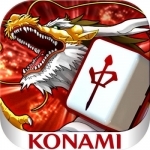
MAH-JONG FIGHT CLUB Sp
Games, Entertainment and Stickers
App
The ultimate online Mah-jong battle game is now available as an app! ...
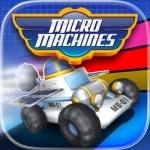
Micro Machines
Games and Stickers
App
The legendary MICRO MACHINES gameplay returns in this all-new multiplayer combat racer from...

NBA JAM by EA SPORTS™ for iPad
Games
App
Read on for important info below! BOOMSHAKALAKA!!!! Jam with a friend in Local Multiplayer and...
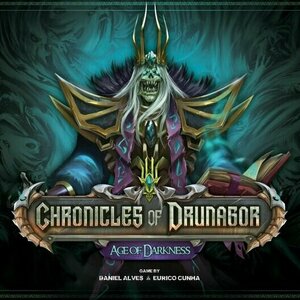
Chronicles of Drunagor: Age of Darkness
Tabletop Game
Daren has always been a land mired in conflict – from the moment the Mortal Races met in its...
